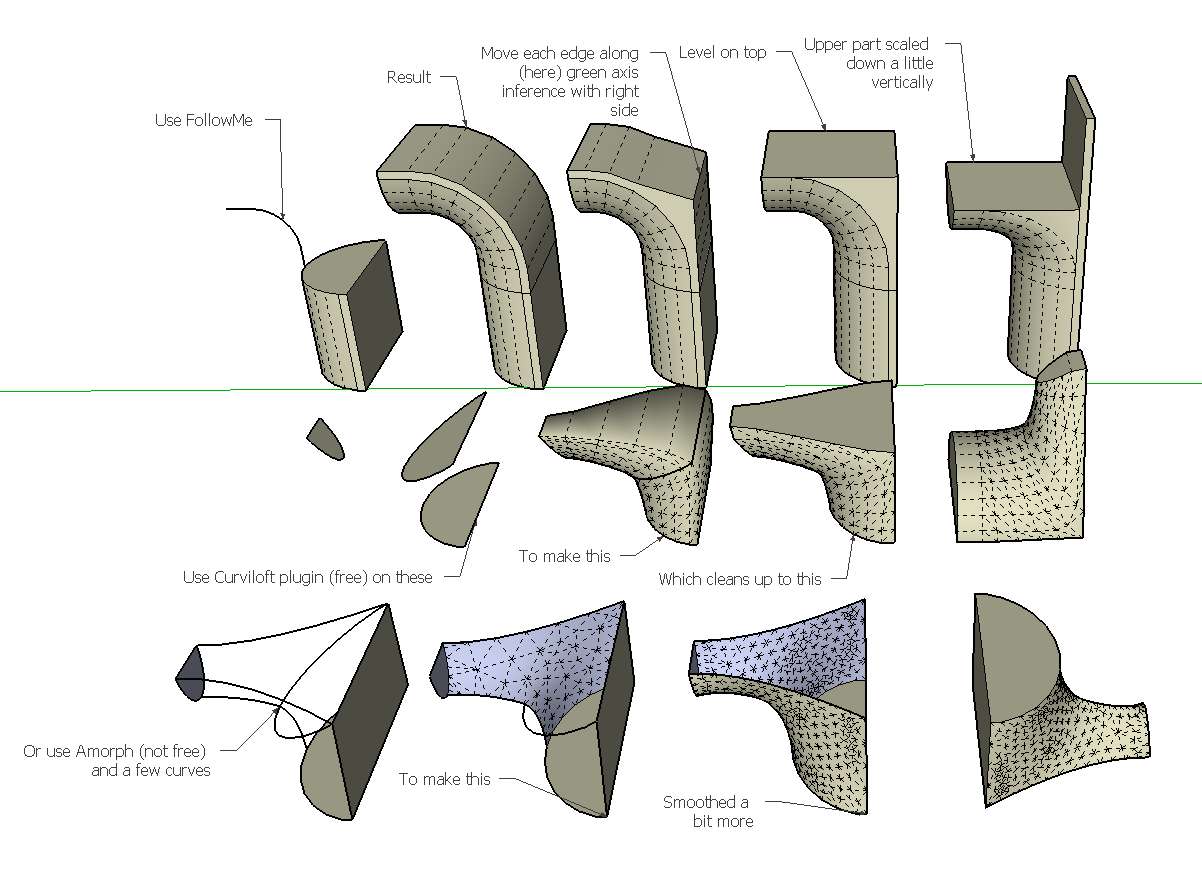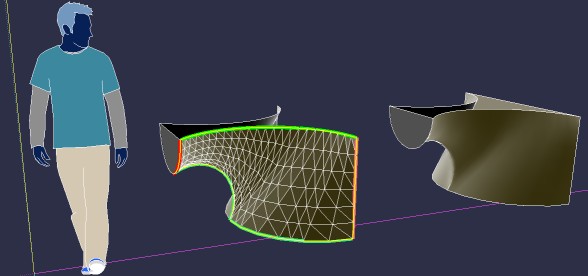How to model a guitar neck
-
Wow! I think I've got it. Now why didn't I think of that?
Thanks!
-Lee -
Ok, I think my first problem was too easy. Any tips on modeling the transition from the neck to the headstock and the neck to the body?
Thanks!

-
Here's a few ways to make the connection between body and neck.

For your simple neck FollowMe should work OK? -
The neck portion of the guitar really has two major parts. The neck itself and the fretboard. Perhaps you do not want this level of detail. Perhaps you do. There happens to be a plugin for fretboards, if you are ready for plugins. I did not use it for the model you see in my avatar, so I don't know how accurate it is. I did my model by measuring my guitar as part of a learning procedure for Sketchup before I became familiar with the routine use of components and scaling instances of components. All of the curves and transitions were hand stitched or progressively push pulled and scaled, like the neck heel to body. And still, it could use some improvement. The headstock machines are components.
-
or Extrude Edges by Rail by TIG


-
@bjornkn Follow me looks like the way to go for the neck body. I will try that. Thanks!
@mitcorb Nice model! I am planning on using this for a blueprint as I may try to build one of these. I have build a couple of full sized guitars, but I saw one of these and thought it would be fun to try and build one like it. I want to get the dimensions as close as possible, and I want all the individual pieces represented. A fretboard plugin sounds pretty cool. . Probably has the spacing calculations built in. There are several fret spacing calculators online, but a sketchup plugin would be nice.
@Pilou Looks pretty advanced - but very cool. I may try that.
-
Well, I guess I could post some "better" images of that model if you think it would help, but I don't want to dilute the point of the thread.
-
Used follow me too and that works great except now I have these holes. Tried a couple of times and got the same thing. Whats happening here? What's the best way to prevent/fix this? Thanks!
-
Lee, I can't tell at this small scale. However on close inspection it looks as if those small triangles are really four sided. Try drawing a straight lime from the narrow vertex to the middle of the opposite side and I think you will find another barely noticeable vertex. At small scales and with complex geometry sometimes !@#$ happens. It is not your fault, but is a result of rounding errors. If it involves small scales, just multiply all dimensions by 10, 100 or 1000. Then remember to scale back when you are done building the geometry. Complex models sometime have spatial ambiguities and failure to close is just the program's way of asking you to help it make a decision. Just select the edges of the hole and use the "create face" command or "plug in" under tools. If it says the edges are "not coplaner" just zoom way way in and you will see a couple of lines not connected. Do some erasing and reconnecting.
I think the architect Mies Van der Rohe said, "The devil is in the details."
-
Hi, lee.:
Perhaps use the method that Dave R has suggested many times in this forum for component modeling for models with small dimensions:
Make a component of the area you are working on. Move/copy a second instance. Scale the second instance up several tens, even 100x of the original, as Roger suggested above. Double click/Edit the large "proxy" component and edit this. Everything you do to this component instance will happen in the original instance. Likewise, if you have to adjust the component to the rest of the model, edit the smaller one, say for pulling vertices into position or something, then go back to the larger one where you have to generate more mesh with tiny dimensions. -
I am starting to get the idea.
I may continue to ask dumb questions since it seems to be faster and less frustrating than staring at my computer for hours and cussing at it for non compliance.
Thanks a lot.
-
If you don't already have it, make keyboard shortcuts for hide/show hidden lines and X-ray on/off.
Then it is much easier to see what's going on.
In that guitar neck there may be some edges inside that should be deleted?
And the holes should probably easily be filled br drawing on top of one of the edges, if the guitar is modeled at a real scale 1:1. If it is smaller you should scale it up to avoid those problems with tiny dimensions. -
This is directed at Lee, but I welcome anyone else to jump in with a different viewpoint.
Never make a model in one big file. Make every part as a separate file and then in your master file do nothing but assemble the pieces.
I break this rule more times than I like to admit and I pay dearly every time. You can also lock components to protect them, but they still contribute to file size and slow response in later phases of construction. The more I do it, the better I like individual files for sub-components so that no drawing is done in the final master file, only assembly.
-
@Roger. Learn something new every day. So you do that primarily for performance or are there other reasons? Does it speed up rendering/navigation or just saving? I use the outliner with groups pretty heavily because it just makes sense to me, but haven't done much with components yet. Not even sure how to work with components from another file or what the implications of that are. What happens if you want to send someone a copy of your sketchup file? Do you have to send all the files together?
-Lee -
People have more problems with large complex project than small simple one. So it helps me break the project into small enough segments that nothing ever becomes overwhelmingly complex. And if I have a fatal error, I can always isolate to problem and toss the damaged component knowing I can bring in a new instance of the damaged piece. And, there is a performance boost.
-
@unknownuser said:
What happens if you want to send someone a copy of your sketchup file? Do you have to send all the files together?
No. SketchUp never uses any external files AFAIK. It's all there inside the .skp file, including images and imported components/files. Makes it very simple to share, but may cause some huge files if you have a lot of textures/images. -
If you've got either SDS or Artisan you can create this quite quickly
[flash=800,600:1h6tx0uj]http://www.youtube.com/v/N9PTkscoCyc[/flash:1h6tx0uj]
-
Thanks Rich, convinced me I need Artisan.
-
-
No problem. Glad to help though my suggestion is the lazy approach. It's important to know how to do this with native tools first.
Advertisement







